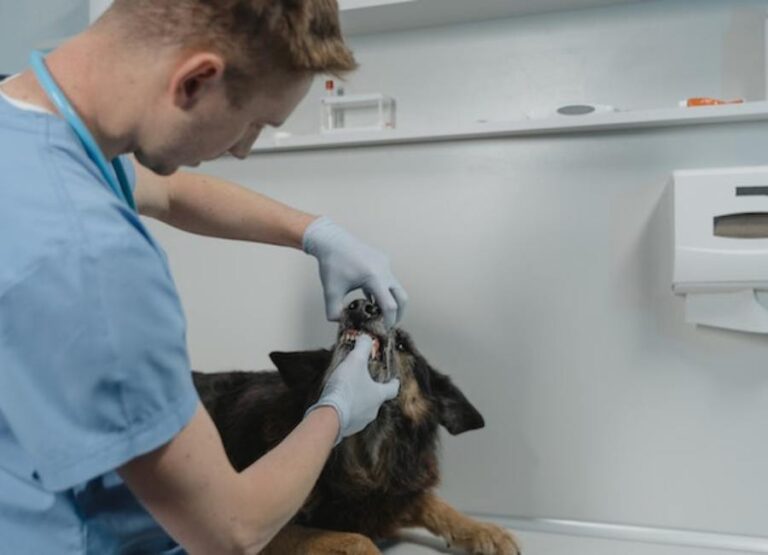Deafness in Dogs [Causes, Signs & Living With a Deaf Dog]
![Deafness in Dogs [Causes, Signs & Living With a Deaf Dog] Deafness in Dogs](https://petcreeks.com/wp-content/uploads/2023/09/pexels-mikhail-nilov-7469222.jpg)
Today, let’s dive into a topic that might be less talked about but equally important – deafness in dogs.
Whether you’re a proud dog parent or considering getting a furry friend, understanding the challenges and joys of living with a deaf dog can make all the difference in creating a loving and inclusive home.
So, let’s explore the world of deafness in dogs together!
What is Deafness in Dogs?
Deafness in dogs refers to the partial or complete loss of hearing ability in a canine.
It can be congenital, meaning the dog is born deaf, or acquired due to factors such as aging, injury, or certain medical conditions.
Deaf dogs may require special care and training techniques to communicate effectively and ensure their safety and well-being.
Causes of Deafness in Dogs
Deafness in dogs can be caused by various factors. One common cause is congenital deafness, which is present from birth and can be inherited.
Certain dog breeds, such as Dalmatians and Australian Shepherds, are more prone to congenital deafness.
Acquired deafness can also occur due to factors like ear infections, trauma to the ear, or exposure to loud noises.
Age-related hearing loss is another cause, typically seen in older dogs. Additionally, certain medications or medical conditions like ototoxicity or autoimmune diseases can contribute to canine deafness.
Read more about the common causes of deafness in dogs.
Recognizing the Signs of Deafness
Deafness in dogs can have various signs and symptoms. Here are some common signs that may indicate deafness in dogs:
Lack of Response to Sound: Dogs with deafness may not respond to their name being called or to other sounds in their environment.
Startling Easily: Deaf dogs may startle easily, especially when approached from behind or when they are not aware of someone’s presence.
Unresponsiveness to Verbal Cues: Deaf dogs may not respond to verbal commands or cues, such as “sit” or “come,” unless they are taught alternative visual or tactile cues.
Excessive Barking: Some deaf dogs may bark excessively, possibly as a way to communicate or get attention since they cannot hear themselves.
Unusual Sleeping Patterns: Deaf dogs may have unusual sleeping patterns, such as sleeping more deeply or being less responsive during sleep.
Uncoordinated or Clumsy Movements: Deafness can affect a dog’s balance and coordination, leading to uncoordinated or clumsy movements.
Lack of Response to Environmental Sounds: Deaf dogs may not react to common environmental sounds like doorbells, door knocks, or the sound of a car approaching.
Increased Aggression or Fearful Behavior: Deaf dogs may exhibit increased aggression or fearful behavior, often due to feeling startled or unable to hear warning signals from other animals or people.
Inability to Localize Sounds: Dogs with deafness may have difficulty locating the source of sounds, often turning their head in different directions or appearing confused.
Read more about the common ways of identifying a deaf dog.
Living with a Deaf Dog
Living with a deaf dog can present unique challenges, but with the right knowledge and understanding, it is possible to have a fulfilling and happy life with your canine companion.
Here are some tips for living with a deaf dog:
Learn how to communicate: Since your dog can’t hear verbal commands, it’s important to find alternative ways to communicate. You can use visual cues, hand signals, and body language to convey your messages. Consistency and repetition are key to helping your dog understand and respond to these cues.
Establish a Signal for their Name: Assign a unique hand signal or visual cue for their name, so they can easily recognize when you are addressing them.
Use positive reinforcement: Positive reinforcement training techniques, such as rewards and treats, can be extremely effective in training a deaf dog. Rewarding desired behaviors will help reinforce them and make training sessions more enjoyable for your dog.
Provide a safe environment: Deaf dogs may be more prone to accidents or getting into hazardous situations, so it’s important to create a safe living environment. Use baby gates or dog gates to restrict access to certain areas, secure fences and doors, and remove any potential hazards or toxic substances from your dog’s reach.
Establish a routine: Deaf dogs thrive on routine and predictability. Establish a consistent daily routine for feeding, exercise, and bathroom breaks. This will help your dog feel secure and reduce their anxiety.
Enrich their sensory experiences: Since your dog can’t rely on their hearing, it’s important to enrich their other senses. Provide plenty of opportunities for sniffing and exploring, use interactive toys that stimulate their senses, and consider using scented markers or essential oils to mark certain areas or objects.
Tag your dog as deaf: Attach an “I am deaf” tag to your dog’s collar or harness. This will alert others that your dog is deaf and may require alternative methods of communication or handling. It can be especially helpful if your dog ever gets lost.
Provide Visual Indicators: Help your deaf dog navigate their environment by providing visual indicators. For example, turn lights on or off to signal different activities or use a flashlight to get their attention.
Socialize your dog: Socialization is important for all dogs, including deaf ones. Expose your dog to various environments, people, and other animals from a young age. This will help them feel more comfortable and confident in different situations.
Avoid Startling: Deaf dogs are more likely to be startled, so it’s important to approach them gently and avoid surprising them. You can lightly touch them or use a vibration collar to get their attention without startling them.
Seek professional guidance: If you’re unsure about how to best care for your deaf dog or need help with training, consider seeking guidance from a professional dog trainer or behaviorist with experience in working with deaf dogs. They can provide valuable advice and techniques tailored to your dog’s specific needs.
Be patient and understanding: Living with a deaf dog requires patience and understanding. Remember that your dog’s deafness does not define them, and they can still live a happy and fulfilling life. Celebrate their unique abilities and focus on building a strong bond based on trust and love.
Living with a deaf dog can be a rewarding experience. With proper training, communication, and a supportive environment, you can provide a happy and fulfilling life for your deaf canine companion.
Read more about living with a deaf dog.
Preventing Deafness in Dogs
While not all cases of deafness can be prevented, there are several measures you can take to reduce the risk or delay the onset of deafness in dogs.
Here are some common ways to prevent deafness in dogs:
1. Regular veterinary check-ups: Regular visits to the veterinarian can help detect and address any underlying health conditions that may contribute to hearing loss. It’s important to catch and treat ear infections or other issues early on.
2. Proper ear hygiene: Keeping your dog’s ears clean and free from excessive wax and debris can help prevent infections and reduce the risk of hearing loss. Your veterinarian can guide you on how to clean your dog’s ears safely.
3. Avoid loud noises: Prolonged exposure to loud noises, such as fireworks, gunshots, or loud music, can damage a dog’s hearing. Whenever possible, keep your dog away from loud environments or use ear protection, such as earmuffs or earplugs, if necessary.
4. Genetic testing: If you are considering getting a dog from a breed that is prone to genetic hearing loss, consider genetic testing to identify potential carriers of hearing-related conditions. Breeding from dogs with a lower risk of passing on hearing loss genes can help reduce the prevalence of deafness in certain breeds.
5. Avoid breeding dogs with hearing loss: If you have a dog with a known hearing loss, it’s advisable not to breed them. This can help prevent passing on genetic hearing loss to future generations.
6. Early intervention for ear infections: Promptly addressing and treating ear infections can help prevent them from progressing and potentially causing hearing loss. Regularly check your dog’s ears for signs of infection, such as redness, swelling, discharge, or odor, and consult your veterinarian if you notice any concerning symptoms.
7. Avoidance of certain medications: Some medications, such as certain antibiotics and certain types of chemotherapy drugs, may have the potential to cause hearing loss in dogs. Consult with your veterinarian about the potential side effects of any medications your dog may be taking.
8. Avoidance of head trauma: Head injuries can sometimes lead to hearing loss in dogs. Take precautions to prevent accidents and minimize the risk of head trauma, such as using proper restraints in vehicles and providing a safe environment at home.
9. Responsible breeding practices: Responsible breeding practices, including selecting breeding partners with good overall health and no history of hearing loss, can help reduce the risk of deafness in future generations.
Read more about dog ear problems.
Treatment Options for Deafness in Dogs
Deafness in dogs can be caused by various factors, including genetics, old age, ear infections, trauma, or certain medications.
The treatment options for deafness in dogs depend on the underlying cause and the severity of the condition. Here are some treatment options for deafness in dogs:
- Management and Training: One approach to managing deafness in dogs is to provide them with a safe and structured environment. This may involve using visual cues and hand signals instead of verbal commands. Training techniques such as positive reinforcement can be used to teach dogs to respond to visual cues and communicate effectively.
- Treatment of Underlying Conditions: If deafness in dogs is caused by an underlying condition such as an ear infection or a tumor, treating or managing that condition may help improve or prevent further hearing loss. This may involve medication, surgery, or other appropriate treatments as recommended by a veterinarian.
- Hearing Aids: Just like humans, dogs can benefit from hearing aids. These devices amplify sound and can help dogs with partial hearing loss or certain types of deafness. However, not all dogs are suitable candidates for hearing aids, and the effectiveness may vary depending on the individual dog and the underlying cause of deafness.
- Cochlear Implants: In some cases of severe or profound deafness, cochlear implants may be considered as a treatment option. A cochlear implant is a surgically implanted device that bypasses the damaged parts of the ear and directly stimulates the auditory nerve, allowing the dog to perceive sound. This procedure is more invasive and costly compared to other treatment options.
- Adaptive Strategies and Support: Deaf dogs can benefit from adaptive strategies and support to enhance their quality of life. This may include using vibrating collars or specialized devices to alert the dog to important sounds, providing a safe and enriched environment, and ensuring proper socialization and communication with humans and other animals.
It is important to note that the effectiveness of these treatment options may vary depending on the individual dog, the underlying cause of deafness, and other factors.
Consulting with a veterinarian or a veterinary specialist is crucial to determine the most appropriate treatment approach for a deaf dog.
Frequently Asked Questions
How common is deafness in dogs?
Deafness in dogs is more common than you might think. Certain breeds, such as Dalmatians, Australian Shepherds, and Bull Terriers, have a higher incidence of deafness. However, it can occur in any breed or mix of breeds.
Can deaf dogs lead a normal life?
Absolutely! Deaf dogs can live happy, fulfilling lives with the right care and training. They rely on their other senses, such as sight and smell, to navigate their surroundings. With patient and consistent training, deaf dogs can learn hand signals and visual cues to communicate effectively.
How can I tell if my dog is deaf?
There are a few signs that may indicate deafness in dogs. If your dog doesn’t respond to sounds that normally get their attention, if they sleep deeply and are difficult to wake up, or if they startle easily when touched from behind, it could be a sign of deafness. However, it’s important to have your dog evaluated by a veterinarian for an accurate diagnosis.
Is deafness in dogs hereditary?
Yes, in some cases, deafness in dogs can be hereditary. Certain genes can contribute to the development of deafness, especially in specific breeds. If you’re considering getting a dog from a breed with a higher risk of deafness, it’s important to work with a responsible breeder who conducts appropriate health tests on their breeding dogs.
Can deaf dogs be trained?
Absolutely! Deaf dogs are incredibly intelligent and can be trained using positive reinforcement methods. Instead of relying on verbal commands, they can learn to respond to visual cues, hand signals, and vibrations. Patience, consistency, and reward-based training techniques are key to successfully training a deaf dog.
Are there any special considerations for caring for a deaf dog?
While deaf dogs can lead normal lives, there are a few considerations to keep in mind. It’s important to ensure their safety by keeping them on a leash or in a securely fenced area, as they won’t be able to hear approaching dangers. Additionally, using visual cues for communication and providing mental stimulation through interactive toys can help keep them engaged and happy. Regular veterinary check-ups are also essential to monitor their overall health.
Read more about dog ear mites.
Conclusion
In conclusion, deafness in dogs is a unique challenge that requires understanding and patience.
By implementing effective communication techniques and providing a loving environment, we can help deaf dogs thrive and lead fulfilling lives.
Remember, with a little extra care, these special pups can bring just as much joy and love into our lives as their hearing counterparts.






